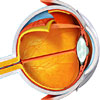Acupuncture may help some older children with lazy eye
Acupuncture could potentially become an alternative to patching for treating amblyopia (lazy eye) in some older children, according to a report in the December issue of Archives of Ophthalmology, one of the JAMA/Archives journals.
About 0.3% to 5% of individuals worldwide have amblyopia, according to background information in the article. About one-third to one-half of the cases are caused by differences in the degree of nearsightedness or farsightedness between the two eyes, a condition known as anisometropia. Correcting these refractive errors with glasses or contact lenses has been shown to be effective in children age three to seven years, but among older children age seven to twelve, only 30% respond to visual correction alone.
Adding occlusion therapy – in which one eye is patched – increases this response rate to two-thirds, but some patients may not comply and those who do may experience emotional problems or reverse amblyopia, the authors note. Jianhao Zhao, MD, of Joint Shantou International Eye Center of Shantou University and Chinese University of Hong Kong, Shantou, China, and colleagues compared acupuncture – which has also been used to treat dry eye and myopia – to patching in a randomised controlled trial involving 88 children.
Of these children, 43 were randomly assigned to the acupuncture group and received five treatments per week targeting five acupoints, or needle insertion sites. The remaining 45 children had their good eye patched for two hours a day and were instructed to do at least one hour of near-vision activities with the lazy eye, such as reading or typing.
After fifteen weeks, visual acuity improved by about 1.8 lines in those whose eyes were patched and 2.3 lines in those who had acupuncture. An improvement of two lines or more occurred in 28 (66.7%) of those in the patching group and 31 (75.6%) of those in the acupuncture group. Lazy eye was considered resolved in 16.7% of patched eyes and 41.5% of eyes in the acupuncture group.
Both treatments were well tolerated; children had no problems complying with either therapy, and no serious adverse effects were found in either group. Acupuncture was performed after school to avoid interfering with participants’ studies.
“Although the treatment effect of acupuncture appears promising, the mechanism underlying its success as a treatment for amblyopia remains unclear,” the authors write. Targeting vision-related acupoints may change the activity of the visual cortex, the part of the brain that receives data from the eyes. It may also increase blood flow to the eye and surrounding structures as well as stimulate the generation of compounds that support the growth of retinal nerves, they note.
“The findings from this report indicate that the treatment effect of acupuncture for amblyopia is equivalent to the treatment effect of patching for amblyopia. However, only patients with anisometropic amblyopia were involved in our study and the follow-up period was relatively short,” the authors conclude. “Moreover, acupuncture itself is a very complicated system of therapy. Differences exist among acupuncturists, and there are divergent manipulation modes, stimulation parameters, treatment styles and subjective sensations evoked by acupuncture stimulation. Because of the good results obtained in our study, the acupoints that we used could be considered for use in clinical practice.”
(Source: JAMA: Archives of Ophthalmology)
More information
 | For more information relatinh to eye protection and the effects of smoking, sunlight, facial hygiene of vision and handy eye exercises, see Protecting Eyesight: How to Have Healthy Eyes. |
Dates
Tags
Created by:

 Login
Login














